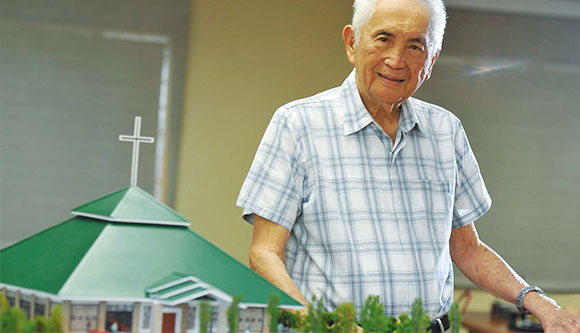David M. Consunji Building A Legacy
By Tina Arceo-Dumlao
On the large desk of David M. Consunji in his office at the Makati City headquarters of the multi-billion peso group that bears his name are two eye-catching figures – a small sculpture of a cow and a piece of concrete.
These simple objects of his affection stand out amid a sea of papers on his desk detailing the latest projects the sprawling Consunji group is involved in. And they are tangible expressions of what the 91-year-old Consunji is all about – a simple farmer at heart and a construction magnate by trade.
Consunji, who still goes to work every day, says it was in his father’s farm in the small town of Hermosa, Bataan where he developed discipline and appreciated the value of putting in an honest day’s work and getting his hands dirty.
He recalls in his memoir entitled “A Passion to Build” that the life at the farm – of fetching water, taking care of carabaos and growing fruits and vegetables – created in him the character traits that became useful to him in his chosen profession as a builder.
“I learned not to be afraid of getting my hands or the rest of me dirty. I learned to have a pragmatic and hands-on approach to life. Many engineers these days have grown leery of dirt and grime; they think of themselves as elite, white-collar workers and they don’t want any work that would sully their hands with dirt. To them, that’s a job for common laborers; they just want to be left alone to do their designs,” Consunji says in his book.
“But my thinking is that unless an engineer has an affinity for actual construction and real labor, he won’t be able to do his work properly. He will not realize that there is another method, another process, of doing what he wants to do and will do it for less cost and effort. This is the kind of knowledge you get only in the field, by actually building things, instead of reading books. And engineers can develop that kind of practical knowledge if they develop, early on, a taste for honest labor and a good day’s work under the sun, such as we did back in Hermosa in the 1920s,” he adds.
Another Path
Consunji says that he actually wanted to take up agriculture but his father dissuaded him, saying that one “idiot” farmer in the family was enough. So he followed his beloved older brother Jorge into the engineering profession instead, enrolling at the University of the Philippines in 1939 to take up civil engineering.
World War II abruptly interrupted his studies and he still recalls with a heavy heart the toll that war took on himself and his family. Their farms and fishponds in Bataan were destroyed. Consunji was even briefly imprisoned by the Japanese and that experience was enough to show how cruel man can be against man.
But what was most painful was the death of his brother, Jorge, whom he describes as “the brightest and kindest” of the Consunji children, the one he was closest to and the reason why he became an engineer.
Fortunately, the war ended and when UP reopened, Consunji was able to resume his engineering studies, albeit in a smaller campus on Padre Faura because the UP buildings were damaged during the fierce fighting and classes were held in whatever was left standing, some were even held in the open air.
Consunji finally graduated in 1946 and passed the board on the same year. Also passing the board exams that year was Consunji’s college sweetheart, Fredesvinda Almeda, who finished Pharmacy. They would eventually marry the next year on March 9, 1947.
With a wife and soon a child on the way, Consunji had to find work. His classmates in UP told him about openings in American companies involved in reconstruction in the Philippines, but the prospects did not excite him. He was not very interested in theoretical and design work, wanting to do something more practical.
He initially turned to repairing houses of his aunt, but what really got him into the field in which he would eventually stand head and shoulders above the rest was his apprenticeship with his older cousin, Ricardo Consunji, also a UP-trained civil engineer.
Early Lessons
He says in his book that it was his cousin Carding who taught him how to make an estimate, how to make a summary of items of work for a project, how to prepare for a bid and how to manage construction projects.
“When I joined him as an apprentice, he had been in construction for 10 years and I remember him telling me how sick and tired he was of estimating. He would say, “Sawang-sawa na ako” (I am sick and tired of this). But I never grew tired of it. I found it fascinating. I would spend many nights doing just that – making an estimate. Carding taught me also how to be able to lay out a building site and countless other details,” Consunji recalls.
After several months working as an apprentice, Consunji was hired as a concrete inspector for the Kuenzle and Streiff building on Dasmariñas St. in Binondo, Manila. He earned P400 a month from his first real job, a big jump from the P100 that he used to earn when he was a teacher in Bataan.
Being a concrete inspector meant that he had to make sure that the concrete used in the construction of the building met standards of strength. And so he had to be there and observe how the workers executed the architectural plans such as the excavation and pouring of the foundation.
That stint impressed on the young engineer the basics of construction and how the margin of error increases dramatically when the work is done by hand. The inconsistencies that necessarily go together with manual methods meant that some aspects of construction met the standards while others did not. Consunji also says in his memoir that the early experience with the Kuenzle and Streiff people gave him the opportunity to work closely with the carpenters, masons, electricians, plumbers and the rest of the construction crew. He stresses that builders must be able to relate well with the workers.
He learned another thing from that concrete inspection job, working with Swiss managers, and that’s to always be on time. “On my first day, when I came in at seven in the morning, the top Swiss manager said that I was late. He said I was a member of the management staff and so I should come in 15 minutes early, so that I could address all the people under me. Of course, I was a bit embarrassed. In the Philippines, arriving early is unusual, but to the Swiss, it was just pure professionalism. It was a lesson that I never forgot. Since that day, I don’t think I have ever been late for any of my engagements or appointments,” stresses Consunji.
A Builder Rises
But his biggest gain from the project was the conviction that he has found his life’s calling, which is to be a builder. His first project as a designer/builder, however, was anything but easy.
Consunji was hired for P500 a month in 1948 to design and build the four-story multipurpose building of Marcelo Rubber Co. in Malabon. And while he was excited to take on the new challenge, he quickly realized the magnitude of the responsibility of making a building that would last.
He bought his first slide rule and pored over his design and computation like never before. He admits that he was an “average” student in UP so he had to elevate his game because his profession demanded it.
Consunji put into the Marcelo building all he had learned in school and from his previous construction projects. And in 10 months, he was done with the first building he could call his own, as he was involved from conception to the pouring of the very last pound of reinforced concrete.
Building owner Peping Marcelo was so happy with his job that he gave Consunji a raise and paid him P600. But despite the pat on the back, he says his designing career began and ended with the Marcelo building. He says he just could not bear the anxiety that came with designing a building, making sure that it will withstand a strong earthquake.
He relates that he was so nervous that he visited the Marcelo building once a month just to make sure it was there. He only stopped after two years of monthly visits because the Marcelo building had caught fire and was demolished. The end of the regular visits was also the end of the line for him as a designer.
Construction Was, After All, His Destiny.
After the Marcelo building was completed, projects came in steadily, each one growing in scale, scope and complexity. To accommodate the increase in the projects that came his way as his reputation for quality and timely work spread, he put up D.M. Consunji Inc. in 1954 with mostly relatives as incorporators.
The company that was established with P3 million in authorized capital built homes, buildings and manufacturing plants. But the single project that would catapult the name DMCI into the building stratosphere was the Chapel of the Holy Sacrifice or simply called the UP Chapel.
The late Fr. John Delaney, the chaplain of UP campus in Diliman, Quezon City, envisioned a church that was open on all sides to let in the air and the sun, and one where the altar would be at the very center so that the priest and the faithful could be one during worship.
The late Leandro Locsin was chosen as architect and Prof. Alfredo Juinio, then dean of the UP civil engineering department, was tasked to be the structural engineer. And for Juinio, only Consunji was up to the task of building a chapel that would require a new kind of concrete and a new way of construction.
Juinio knew that Consunji had been testing samples of strong concrete that can withstand pressure of between 3,000 and 4,000 pounds per square inch, and that was exactly what he needed to execute Locsin’s delicate design. Anything weaker just would not do.
In the end, despite all the challenges that came with building something new, Consunji delivered on the concrete, which was stronger and cheaper to produce than weaker concrete, and the chapel was completed.
The first mass in the new chapel was celebrated on Dec. 25, 1955 and 57 years later, the chapel remains intact and has the distinction of being the only chapel worked on by four National Artists – Architect Leandro Locsin; sculptor Napoleon Abueva who executed the huge crucifix hanging at the very center of the dome; painter Vicente Manansala, who interpreted the 14 stations of the cross on the walls of the chapel and finally Arturo Luz, who was responsible for the mural made of terrazzo on the floor of the chapel.
A frequent visitor to the UP Chapel jobsite who appreciated exactly what the chapel represented in the history of construction in the Philippines was artist Fernando Zobel. He was a top executive of Ayala Corp., which in 1955 was just starting to develop what would become the Philippines’ largest and most prestigious central business district.
Making Makati
Zobel was so impressed by the team behind the UP Chapel project that he got them involved in the development projects in Makati. Locsin would become the preferred architect; Juinio the structural engineer for the buildings and then Consunji for the construction.
The team, fresh from the successful execution of thin-shell construction and the use of strong concrete, built in 1959 the first structure in the Makati business district, which was the seven-storey Monterey Apartment on Ayala Avenue.
That structure ushered the rush to build high-rise buildings in Makati, and D.M. Consunji would be involved in a good number of these landmark projects, some of which are unfortunately no longer around such as the Rizal Theater, where the Makati Shangri-La now stands, and the SMC-Soriano Bldg. that has given way to the Enterprise Building.
“The Ayala group really helped us very much. They helped us to grow. We were the trusted people to execute what they wanted,” says Consunji, adding that it was a relationship based on trust and not so much about pesos and centavos.
Over the next 50 years, DMCI would put up almost half of the buildings in the Makati central business district. As expected, the older buildings have given way to new structures and Consunji says that the other contractors have been complaining because of the difficulty in tearing them down. “The buildings were just so strong,” Consunji says with a laugh.
Consunji did not compromise then and his company, which is now in the hands of his children led by eldest son, Isidro, certainly has no plans of starting now. The company cannot afford to as the group has grown exponentially over the past 58 years.
A Strong Foundation
At of the end of 2011, the company founded by the onetime Secretary of Public Works and Highways under the late President Ferdinand Marcos and a Management Man of the Year awardee, posted a net income of P9.6 billion, up 22 percent from the P7.9 billion recorded in 2010.
From construction, DMCI Holdings has expanded to other vital sectors of the economy such as real estate, power, water, nickel mining and coal mining. These sectors may not seem related at first glance, but Consunji says that at their core, they are about engineering, which is what Consunji knows like the back of his hand.
Consunji, who still visits the group’s work sites every weekend, says he is confident that he has laid a strong foundation for DMCI to carry on its good work involving his eight children.
“They have their own specialization and they will need each other. As long as they are together, they will do well,” predicts Consunji.
And in so doing make sure that the legacy of the inimitable David M. Consunji will live on.









Pingback: David M. Consunji: Master Builder
Reading this article gives me chill and I don’t even know why. Maybe it is all about the man and his passion for his craft and his work ethics. The line that says, “…the other contractors have been complaining because of the difficulty in tearing them down” hit me. How many of construction firm works that way nowadays?
I think it can also be related to other areas of life. Like building a solid financial foundation that no amount of commercialism and propaganda will be able to it tear down so easily.
Nice article. Kudos, Money Sense!